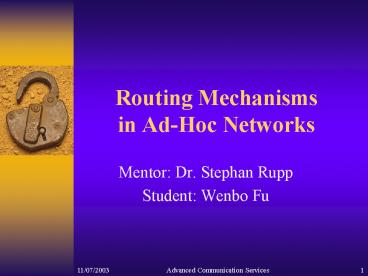Routing Mechanisms in Ad-Hoc Networks - PowerPoint PPT Presentation
1 / 24
Title:
Routing Mechanisms in Ad-Hoc Networks
Description:
Classification of Routing Protocols for MANET (Topology based) ... MANET: Mobile Ad hoc Network (IETF working group) 11/07/2003. Advanced Communication Services ... – PowerPoint PPT presentation
Number of Views:59
Avg rating:3.0/5.0
Title: Routing Mechanisms in Ad-Hoc Networks
1
Routing Mechanisms in Ad-Hoc Networks
- Mentor Dr. Stephan Rupp
- Student Wenbo Fu
2
Ad-hoc Network
- DefinitionAd hoc network is a collection of
wireless nodes that can dynamically be set up
anywhere and anytime without using any
pre-existing network infrastructure.
- Application- Military battlefield.
- - Disaster field
- - Conference
- - Sensor Dust
3
Characteristics of Ad hoc Network
- Ad hoc Network is a mobile, mutlihop, wireless
network with autonomous terminals.
- Dynamic topologies - Bandwidth-constrained -
Energy-constrained operation - Limited physical
security
4
How to find a route in Ad hoc Network?
5
Agenda
- Overview of Ad-Hoc Network Routing Protocol
- Proactive Ad-Hoc Routing Protocols (Link-State)
- Reactive Ad-Hoc Routing Protocols
- Conclusions
6
Classification of Routing Protocols for MANET
(Topology based)
7
Proactive vs Reactive Routing Protocols
- Proactive routing protocols (table-driven
protocols) attempt to maintain consistent, up to
date routes from each node to every other nodes
in the network. - Reactive routing protocols (on-demand driven
protocols) create routes only when desired by the
source node.
8
Proactive vs Reactive Routing Protocols
- Proactive Routing Protocols
- Routes to all reachable nodes in the network
available. - Minimal initial delay for application.
- - Larger signalling traffic and power
consumption. - Reactive Routing Protocols
- Smaller signalling traffic and power
consumption. - - A long delay for application when no route to
the destination available
9
Agenda
- Overview of Ad-Hoc Network Routing Protocol
- Proactive Ad-Hoc Routing Protocols (Link-State)
- Reactive Ad-Hoc Routing Protocols
- Conclusions
10
Update local Link -State relevant tables
11
Overhead of Link-State Protocols
- Message generation
- - What, Who, When
- Message processing
- - Local tables updating
- - Route computation
- Message forwarding
- - Who
- Goal Decrease unnecessary overhead.
12
OLSR (Optimized Link State Routing Protocol)
- - MPR (Multipoint relays)- MPR selector-
Symmetric 1-hop neighbours- Symmetric strict
2-hop neighbours
13
TBRPF (Topology Dissemination Based on
Reverse-Path Forwarding)
- Reported Nodes set (RN)
- Reported Tree (RT)
- Local links
- Dijkstras algorithm
14
Comparison between OLSR and TBRPF
15
Agenda
- Overview of Ad-Hoc Network Routing Protocol
- Proactive Ad-Hoc Routing Protocols (Link-State)
- Reactive Ad-Hoc Routing Protocols
- Conclusions
16
Procedure Diagram of Reactive Protocols
17
Overhead of Reactive Protocols
- Route discovery
- - Information maintained in intermediate nodes
- - Information contained or hidden in messages
- - Length of flooding
- Route maintenance
- - How to find an alternative route
- - How to inform influenced nodes
- Goal Minimize application delay and decrease
unnecessary overhead.
18
AODV (Ad hoc On-Demand Distance Vector)
- Intermediate nodes - Backward and forward
path.- Precursor list
- Expanding ring search (TTL)
19
DSR ( Dynamic Source Routing)
- Muliple path- Load balance- Packet salvaging
20
Comparison between AODV and DSR
21
Agenda
- Overview of Ad-Hoc Network Routing Protocol
- Proactive Ad-Hoc Routing Protocols (Link-State)
- Reactive Ad-Hoc Routing Protocols
- Conclusions
22
Conclusions
- Four candidates for standard protocols of IETF
with different features. - Algotithms are continuously modified and
improved. - Feasibility still needs to be tested in practice.
- No clear winners among specification.
- Issues such as security and interworking should
be emphasized in future.
23
Acknowledgements
- Dr. Stephan Rupp
- Prof. Paul J. Kuehn
- Miss Napat Nantavechsanti
- Mr. Thomas Buergstein
24
- Q A





















![[AD Hoc Networks] PowerPoint PPT Presentation](https://s3.amazonaws.com/images.powershow.com/8371435.th0.jpg?_=20161231113)









